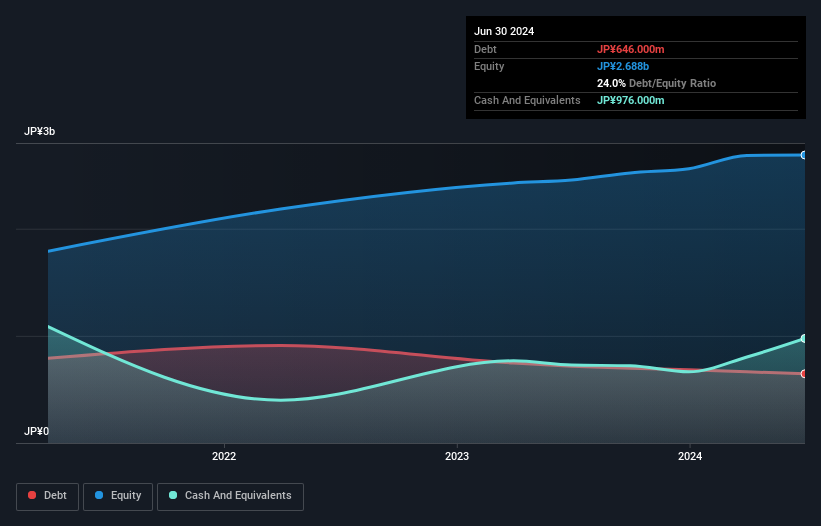- Japan
- /
- Electronic Equipment and Components
- /
- TSE:7116
DAIWA TSUSHIN (TSE:7116) Seems To Use Debt Quite Sensibly
Some say volatility, rather than debt, is the best way to think about risk as an investor, but Warren Buffett famously said that 'Volatility is far from synonymous with risk.' So it seems the smart money knows that debt - which is usually involved in bankruptcies - is a very important factor, when you assess how risky a company is. Importantly, DAIWA TSUSHIN Co., Ltd (TSE:7116) does carry debt. But the real question is whether this debt is making the company risky.
When Is Debt Dangerous?
Debt is a tool to help businesses grow, but if a business is incapable of paying off its lenders, then it exists at their mercy. If things get really bad, the lenders can take control of the business. However, a more frequent (but still costly) occurrence is where a company must issue shares at bargain-basement prices, permanently diluting shareholders, just to shore up its balance sheet. Of course, the upside of debt is that it often represents cheap capital, especially when it replaces dilution in a company with the ability to reinvest at high rates of return. When we think about a company's use of debt, we first look at cash and debt together.
See our latest analysis for DAIWA TSUSHIN
What Is DAIWA TSUSHIN's Net Debt?
As you can see below, DAIWA TSUSHIN had JP¥646.0m of debt at June 2024, down from JP¥717.0m a year prior. But on the other hand it also has JP¥976.0m in cash, leading to a JP¥330.0m net cash position.

How Healthy Is DAIWA TSUSHIN's Balance Sheet?
We can see from the most recent balance sheet that DAIWA TSUSHIN had liabilities of JP¥551.0m falling due within a year, and liabilities of JP¥542.0m due beyond that. On the other hand, it had cash of JP¥976.0m and JP¥512.0m worth of receivables due within a year. So it can boast JP¥395.0m more liquid assets than total liabilities.
This short term liquidity is a sign that DAIWA TSUSHIN could probably pay off its debt with ease, as its balance sheet is far from stretched. Succinctly put, DAIWA TSUSHIN boasts net cash, so it's fair to say it does not have a heavy debt load!
Fortunately, DAIWA TSUSHIN grew its EBIT by 5.6% in the last year, making that debt load look even more manageable. There's no doubt that we learn most about debt from the balance sheet. But it is DAIWA TSUSHIN's earnings that will influence how the balance sheet holds up in the future. So when considering debt, it's definitely worth looking at the earnings trend. Click here for an interactive snapshot.
Finally, a business needs free cash flow to pay off debt; accounting profits just don't cut it. DAIWA TSUSHIN may have net cash on the balance sheet, but it is still interesting to look at how well the business converts its earnings before interest and tax (EBIT) to free cash flow, because that will influence both its need for, and its capacity to manage debt. In the last three years, DAIWA TSUSHIN's free cash flow amounted to 40% of its EBIT, less than we'd expect. That's not great, when it comes to paying down debt.
Summing Up
While it is always sensible to investigate a company's debt, in this case DAIWA TSUSHIN has JP¥330.0m in net cash and a decent-looking balance sheet. And it also grew its EBIT by 5.6% over the last year. So is DAIWA TSUSHIN's debt a risk? It doesn't seem so to us. The balance sheet is clearly the area to focus on when you are analysing debt. However, not all investment risk resides within the balance sheet - far from it. For example DAIWA TSUSHIN has 3 warning signs (and 2 which are a bit unpleasant) we think you should know about.
At the end of the day, it's often better to focus on companies that are free from net debt. You can access our special list of such companies (all with a track record of profit growth). It's free.
New: Manage All Your Stock Portfolios in One Place
We've created the ultimate portfolio companion for stock investors, and it's free.
• Connect an unlimited number of Portfolios and see your total in one currency
• Be alerted to new Warning Signs or Risks via email or mobile
• Track the Fair Value of your stocks
Have feedback on this article? Concerned about the content? Get in touch with us directly. Alternatively, email editorial-team (at) simplywallst.com.
This article by Simply Wall St is general in nature. We provide commentary based on historical data and analyst forecasts only using an unbiased methodology and our articles are not intended to be financial advice. It does not constitute a recommendation to buy or sell any stock, and does not take account of your objectives, or your financial situation. We aim to bring you long-term focused analysis driven by fundamental data. Note that our analysis may not factor in the latest price-sensitive company announcements or qualitative material. Simply Wall St has no position in any stocks mentioned.
About TSE:7116
Moderate risk with imperfect balance sheet.
Market Insights
Community Narratives


Recently Updated Narratives


No miracle in sight


Q3 Outlook modestly optimistic


Alphabet: The Under-appreciated Compounder Hiding in Plain Sight
Popular Narratives


The company that turned a verb into a global necessity and basically runs the modern internet, digital ads, smartphones, maps, and AI.


MicroVision will explode future revenue by 380.37% with a vision towards success



